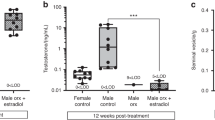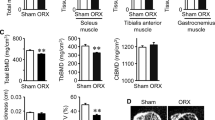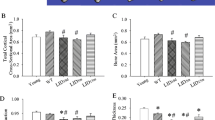Abstract
As humans age, they lose both muscle mass and strength (sarcopenia). Testosterone, a circulating hormone, progressively declines in aging and is associated with loss of muscle mass and strength. The surgical joining of a young and old mouse (heterochronic parabiosis) activates Notch signaling and restores muscle regenerative potential in aged mice. We hypothesize that testosterone is at least one of the factors required for the improvement seen in muscles in old mice in heterochronic parabiosis with young mice. To test this hypothesis, we established the following heterochronic parabioses between young (Y; 5 months old) and old (O; 22–23 months old) C57BL6 male mice: (1) Y:O; (2) castrated Y:O (ØY:O); (3) castrated + testosterone-treated Y:O (ØY + T:O). A group of normal young mice received empty implants, and old mice were used as controls. Parabiotic pairings were maintained for 4 weeks prior to analysis. Serum testosterone levels were three-fold higher in young than in old mice. The ØY + T:O pairing demonstrated significantly elevated levels of serum testosterone and an improvement in gastrocnemius muscle weight, muscle ultrastructure, muscle fiber cross-sectional area, and Notch-1 expression in old mice. These changes were not present in aged mice in the ØY:O pairing. These data indicate that testosterone has a critical role in mediating the improved muscle mass and ultrastructure seen in an experimental model of heterochronic parabiosis.



Similar content being viewed by others
References
Agbulut O, Destombes J, Thiesson D, Butler-Browne G (2000) Age-related appearance of tubular aggregates in the skeletal muscle of almost all male inbred mice. Histochem Cell Biol 114:477–481
Baumgartner RN, Koehler KM, Gallagher D, Romero L, Heymsfield SB, Ross RR, Garry PJ, Lindeman RD (1998) Epidemiology of sarcopenia among the elderly in New Mexico. Am J Epidemiol 147:755–763
Bonnard C, Durund A, Peyrol S, Chanseaume E, Chauvin M-A, Morio B, Vidal H, Rieusset J (2008) Mitochondrial dysfunction results from oxidative stress in the skeletal muscle of diet-induced insulin-resistant mice. J Clin Invest 118:789–800
Brack AS, Conboy MJ, Roy S, Lee M, Kuo CJ, Keller C, Rando TA (2007) Increased Wnt signaling during aging alters muscle stem cell fate and increases fibrosis. Science 317:807–810
Braga M, Sinha Hikim AP, Datta S, Ferrini M, Brown D, Kovacheva EL, Gonzalez-Cadavid NF, Sinha-Hikim I (2008) Involvement of oxidative stress and caspase 2-mediated intrinsic pathway signaling in age-related increase in muscle cell apoptosis in mice. Apoptosis 13:822–832
Conboy IM, Conboy MJ, Smythe GM, Rando TA (2003) Notch mediated restoration of regenerative potential to aged muscle. Science 302:1575–1577
Conboy IM, Conboy MJ, Wagers AJ, Girma ER, Weissman IL, Rando TA (2005) Rejuvenation of aged progenitor cells by exposure to a young systemic environment. Nature 433:60–764
Conboy MJ, Conboy IM, Rando TA (2013) Heterochronic parabiosis: historical perspective and methodological considerations for studies of aging and longevity. Aging Cell 12:525–530
Corsetti G, Pasini E, D’Antona G, Nisoli E, Flati V, Assanelli D, Dioguardi FS, Bianchi R (2008) Morphometric changes induced by amino acid supplementation in skeletal and cardiac muscles of old mice. Am J Cardiol 101 (suppl):26E–34E
Crane JD, Devries MC, Safdar A, Hamadeh MJ, Tarnopolsky MA (2010) The effect of aging on human skeletal muscle mitochondrial and intramyocellular lipid ultrastructure. J Gerontol A Biol Sci Med Sci 65A:119–128
Cruz-Orive LM, Weibel ER (1990) Recent stereological methods for cell biology: a brief survey. Am J Physiol 258:L148–L156
Cunningham GR, Toma SM (2011) Why is androgen replacement in males controversial? J Clin Endocrinol Metab 96:38–52
Glass D, Roubenoff R (2010) Recent advances in the biology and therapy of muscle wasting. Ann N Y Acad Sci 1211:25–36
Jain D, Sharma MC, Sarkar C, Suri V, Sharma SK, Singh S, Das TK (2008) Tubular aggregate myopathy: a rare form of myopathy. J Clin Neurosci 15:1222–1226
Kaminska AM, Fidzianska A, Schulze G, Coper H, Ossowska K, Wolfarth S, Hausmanowa-Petrusewicz I (1998) Ultrastructural changes in the skeletal muscle of senile rats with significant age-dependent motor deficits. Basic Appl Myol 8:185–190
Kovacheva EL, Sinha Hikim AP, Shen R, Sinha I, Sinha-Hikim I (2010) Testosterone supplementation reverses sarcopenia in aging through regulation of myostatin, c-Jun NH2-terminal kinase, Notch, and Akt signaling pathways. Endocrinology 151:628–638
Mahapatra N, O’Connor DV, Vainganker SM, Sinha Hikim AP, Mahata M, Ray S, Staite E, Wu H, Gu Y, Dalton N, Kennedy B, Ziegler M, Ross J, Mahata S (2005) Targeted ablation of chromogranin A gene: elevated blood pressure rescued by human homolog. J Clin Invest 115:1942–1952
Mahjneh I, Lamminen A, Tuominen H (2007) Episodic muscle pain, stiffness, and weakness associated with tubular aggregates and myoedema. Eur J Neurol 14:569–571
Martin C, Dubouchaud H, Mosoni L, Chardigny J-M, Oudot A, Fontaine E, Vergely C, Keriel C, Rochette L, Leverve X, Demaison L (2007) Abnormalities of mitochondrial function can partly explain the metabolic disorders encountered in sarcopenic gastrocnemius. Aging Cell 1:1–13
Marzetti E, Leeuwenburgh C (2006) Skeletal muscle apoptosis, sarcopenia and frailty at old age. Exp Gerentol 41:234–1238
Niakan E, Harati Y, Danon MJ (1985) Tubular aggregates: their association with myalgia. J Neurol Neurosurg Psych 48:882–886
Rosenbergh NL, Neville HE, Ringel SP (1985) Tubular aggregates. Their association with neuromuscular diseases including the syndrome of myalgias/cramps. Arch Neurol 42:973–976
Roubenoff R, Hughes VA (2000) Sarcopenia: current concepts. J Gerentol A Biol Sci Med Sci 55:716–724
Shadrach JL, Wagers AJ (2011) Stem cells for skeletal muscle repair. Philos Trans R Soc Lond Biol 366:2297–2306
Sinha-Hikim I, Cornford M, Gaytan H, Lee ML, Bhasin S (2006) Effects of testosterone supplementation on skeletal muscle fiber hypertrophy and satellite cells in community dwelling, older men. J Clin Endocrinol Metab 91:3024–3033
Sinha-Hikim I, Braga M, Shen R, Sinha Hikim AP (2007) Involvement of c-Jun NH2-terminal kinase and nitric oxide-mediated mitochondria-dependent intrinsic pathway signaling in cardiotoxin-induced muscle cell death: role of testosterone. Apoptosis 12:965–1978
Sinha-Hikim I, Sinha-Hikim AP, Parveen M, Shen R, Goswami R, Tran P, Crum A, Norris KC (2013) Long-term supplementation with a cystine-based antioxidant delays loss of muscle mass in aging. J Gerontol A Biol Sci Med Sci 68:749–759
Spitzer M, Huang G, Basaria S, Travison TG, Bhasin S (2013) Risk and benefits of testosterone therapy in older men. Nat Rev Endocrinol 9:414–424
Wagers AJ, Sherwood R, Christensen JL, Weissman IL (2002) Little evidence for developmental plasticity of adult hematopoietic stem cells. Science 297:2256–2259
Acknowledgments
We thank the Oxidative Core Laboratories of the National Institutes of Health Accelerating Excellence in Translational Science (grant U54 MD007598) at Charles R. Drew University of Medicine and Science for performing Western blot and hormone assays.
Author information
Authors and Affiliations
Corresponding author
Additional information
This work was supported by National Institutes of Aging Grant F32 AG034703 (to I.S.) and by NIH 1 RO1 AG033053 and 1 P30 AG031679 (to A.J.W.).
The authors have nothing to disclose.
Rights and permissions
About this article
Cite this article
Sinha, I., Sinha-Hikim, A.P., Wagers, A.J. et al. Testosterone is essential for skeletal muscle growth in aged mice in a heterochronic parabiosis model. Cell Tissue Res 357, 815–821 (2014). https://doi.org/10.1007/s00441-014-1900-2
Received:
Accepted:
Published:
Issue Date:
DOI: https://doi.org/10.1007/s00441-014-1900-2




